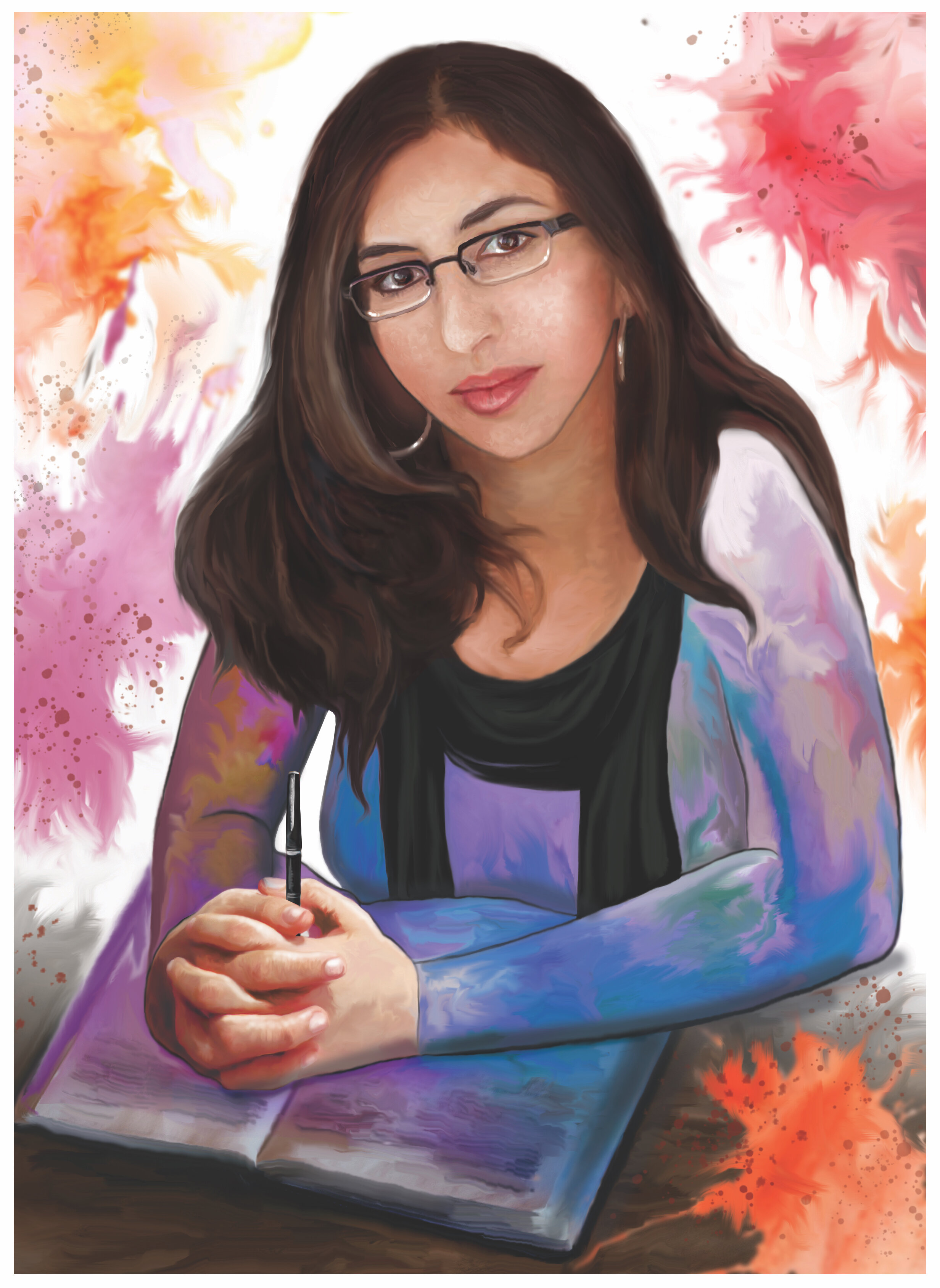The following is a sample profile from the book Holy Troublemakers & Unconventional Saints by Daneen Akers.
Rabbi Danya Ruttenberg
One clear night in 1997 in Provincetown, Rhode Island, the moon is high and luminous. Below it, a young woman is walking on the street, listening to Tchaikovsky on her Walkman. As the piano music in her ears rises and falls in intensity, she feels like she’s seeing the moon for the first time. It would be the first of many such walks. “I had never really looked at the moon, and now I was addicted. Some nights the sky was clear, and it would spread wide, clean light in all directions. On cloudy nights it would appear through a haze, swaddled in a muted rainbow,” she later remembers. “I began to connect to something long buried that only had permission to stir as I traversed the winding streets, more than a little lost.”
This young woman’s name is Danya Ruttenberg. She was feeling lost because, six months before, her mother had died of breast cancer, and she was in mourning. She was trying to finish her last year of college and somehow make sense of her life in the midst of her sorrow. Often when she walked or biked through the streets of Provincetown under the light of the moon, she wept. All of the emotions she’d been trying to hold back during the day finally had a chance to bubble up to the surface. But, she knew, the moon didn’t mind her tears. She talked to the moon sometimes, too. Her words didn’t always make sense, but she found that the moon is a good listener.
Illustration by Agnerys Gonzalez
Gradually, she felt something else stir inside of her as she walked and talked to the moon. This feeling was hard to put into words. In fact, she described this feeling as “the stuff that is a little beyond language.” She found herself noticing things, things as simple as the leaves on a tree or weeds growing between the sidewalk cracks. Observing them, she felt amazement and a new stillness inside of herself. She felt brief moments of magic when she felt connected to a much bigger something beyond herself. These nights under the moon left her with an openness that hadn’t been there before.
In time, these little moments of wonder and openness under the light of the moon connected with other shifts inside Danya. She found herself beginning to imagine something that surprised her: She realized that she was starting to believe in God.
This was a surprising development because Danya was an atheist. Her family was Jewish, and she’d celebrated important holy days with them at the synagogue. But, from the time she was 13, she’d been a committed atheist. And Danya is the type of person who doesn’t take commitments lightly. She’d read widely and knew all of the major religions and schools of thought about if there might be a higher power in the universe. Just the thought that she might actually believe in something beyond this physical world made Danya uncomfortable. The very idea made her “a little bit nervous, a little bit jittery, and rather nauseous.”
Part of the reason the realization that she just might believe in God made Danya so uncomfortable is that the images and words she’d grown up with about God were images and ideas she didn’t agree with.
Try this experiment: Say “God” out loud. What do you imagine? Even if we don’t want to, many of us first see a big, bearded, White man up on cloud or a throne somewhere, probably looking serious. Those images of a White, male God somewhere “up there” fill our culture. Everything from books to music to art to everyday language support that image of God.
But Danya began to realize that this “Guy in the Sky” idea of God wasn’t what she was connecting with. The bigger reality she was connecting to was deeper and more powerful than what she had considered before.These ideas about God in sacred texts, art, and songs are all metaphors for God. They point to ideas about God, but we often make the mistake of thinking they are actual pictures of God, like a police report entered into evidence in a courtroom. They are simply ideas that worked for some people in some particular times and places to describe what they experienced as God. God is ultimately beyond language, but we keep trying to find language to describe our experiences of God to other people.
Danya gradually started connecting her newfound spirituality to going to synagogue, which she’d begun doing as part of the Jewish mourning rituals for her mother. The services felt different when she saw them as connected to her late-night walks. She also, little by little, started practicing many of the customs that religiously observant Jews have practiced for several thousands of years.
She began keeping Shabbat, or the Sabbath. So, beginning at sundown on Friday night until after sundown on Saturday night, she stopped doing her usual work. She also stopped running errands, doing chores, cooking, and using the phone on the Sabbath. One of her favorite rabbis who wrote extensively about the practice of keeping Sabbath, Abraham Heschel, called Sabbath a “sanctuary in time,” a special space to connect with God, self, and other people.
In some ways, becoming a (mostly) observant Jew surprised Danya almost as much as her realization that she believed in God. She’d scoffed at many of those rules and customs as a child. However, she started to realize that many thoughtful people had come up with these customs over thousands of years so that someone like Danya could step into a deep spiritual practice without having to invent everything from scratch. When we step into religious traditions that people have been practicing for thousands of years, we get to step into the wisdom that’s accumulated over all of that time.
Danya is quick to point out that sometimes traditions and customs need to be adjusted, especially in light of our current understanding of what is fair and just. But overall, the accumulated wisdom of thousands of years gives her faith a depth that she wouldn’t find on her own. “Shabbat is not always comfortable or convenient. Sometimes you just want to watch Netflix or check social media on a Friday night. But that’s why a spiritual practice that you do with a community matters so much. A spiritual practice is meant to bring you somewhere where you wouldn’t get on your own. That’s the value of it.”
Danya continued to find her study of Judaism thought-provoking and life-giving, and in 2008, she went to rabbinical school. She’s now a rabbi, writer, activist, and mother. She often teaches people, including her three children, about how Judaism engages the world with a unique perspective. “Judaism teaches that our job is to show up to help people,” she says. “What we do matters.”
She takes this job seriously. In addition to her work as a rabbi and writer, she works with several organizations that try to make our society more just and fair. She knows that working to make systems more fair means, for example, not only giving a homeless person food, clothing, medical care, and shelter.That’s important because that person is suffering and needs help. But it’s also important to try to solve the underlying systems that are often failing people in the first place.
To Danya, showing up to love and help other people is how we love God. “The way to love God is to love God’s creation. Our one job is to care for the stranger, the poor, the widow, the vulnerable. We honor God when we care for other people.”
What is one way you can love God’s creation?
Glossary Terms
Activist
A person who works for some kind of social change, from gathering signatures to keep a local library open to marching to protest an unfair law.
Atheist
A person who does not believe in God, gods, or any other higher power.
Culture
The customary beliefs, traditions, art, food, dress, and ideas of a particular people and place.
Jewish/Judaism
A person who follows Judaism, which is likely the world’s oldest monotheistic religion (belief in only one God). Judaism was formed nearly 4,000 years ago by the ancient Hebrews. Jews believe God formed a special covenant with Abraham to form a great nation from his descendants if he followed God’s directions. Judaism is one of the three Abrahamic faiths and emphasizes living a just and compassionate life that respects all people as made in the image of God.
Rabbi
A Jewish scholar, teacher, or religious leader.
Shabbat/Sabbath
The day of rest in Judaism, beginning just before sunset on Friday evening and ending on Saturday night after sundown; religiously observant Jews do not work on Sabbath but instead go to worship at their synagogues and spend the day with their families and communities.
Spiritual
Something that relates to the human soul or spirit.
Synagogue
The building where Jewish congregations gather for worship, instruction, and community.
Walkman
Portable, personal music players that played cassette tapes; very popular in the 1980s and used with headphones. Today we use iPods or smartphones to listen to music with headphones or earbuds, but before their invention, people used Walkmans.
Read another sample chapter from the Holy Troublemakers & Unconventional Saints book by Daneen Akers.



